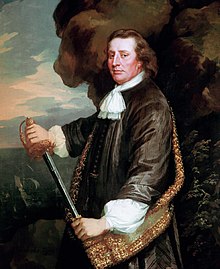Christopher Myngs
| Sir Christopher Myngs | |
|---|---|

Christopher Myngs, by Sir Peter Lely, 1666, part of the Flagmen of Lowestoft series
|
|
| Born | 1625 Norfolk, England |
| Died | 1666 (aged 40–41) London, England |
| Allegiance |
|
| Service/branch |
|
| Rank | Vice Admiral |
| Commands held |
Elisabeth Marston Moor Jamaica Station |
| Battles/wars |
First Anglo-Dutch War Anglo-Spanish War Second Anglo-Dutch War |
Vice Admiral Sir Christopher Myngs (1625–1666), English naval officer and privateer, came of a Norfolk family and was a relative of another admiral, Sir Cloudesley Shovell. Samuel Pepys' story of his humble birth, in explanation of his popularity, is said to be erroneous. His name is often given as Mings.
The date of Myngs's birth is uncertain, but probably somewhere between 1620 and 1625. It is probable that he saw a good deal of sea-service before 1648. He first appears prominently as the captain of the Elisabeth, which after a sharp action during the First Anglo-Dutch War brought in a Dutch convoy with two men-of-war as prizes. From 1653 to 1655 he continued to command the Elisabeth, high in favour with the council of state and recommended for promotion by the flag officers under whom he served.
In 1655, he was appointed to the frigate Marston Moor, the crew of which was on the verge of mutiny. His firm measures quelled the insubordinate spirit, and he took the vessel out to the West Indies, arriving in January 1656 on Jamaica where he became the subcommander of the naval flotilla on the Jamaica Station, until the summer of 1657.
In February 1658, he returned to Jamaica as naval commander, acting as a commerce raider during the Anglo-Spanish War. During these actions he got a reputation for unnecessary cruelty, sacking and massacring entire towns in command of whole fleets of buccaneers. In 1658, after beating off a Spanish attack, he raided the coast of South-America; failing to capture a Spanish treasure fleet, he destroyed Tolú and Santa Maria in present-day Colombia instead; in 1659 he plundered Cumaná, Puerto Cabello and Coro in present-day Venezuela.
...
Wikipedia
